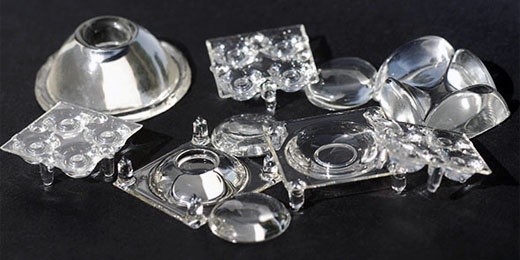Optical lenses present a unique challenge when it comes to 3D printing, but Luxexcel has risen to the challenge with its patented Printoptical Technology. The question is why?
We already have a tried and trusted method for producing optical lenses and there are good reasons for sticking with them.
For a lens to work effectively then light must be able to travel uninterrupted through the material. Any imperfections in the material can either degrade or refract the light, which means it simply doesn’t work.
Layer by layer printing doesn’t work
The layer by layer printing method is ineffective by design. Each layer is melted, laid on top of the previous one and then cured. That means there is a bond between the two, an uneven surface and distortion is baked in to the whole approach.
This doesn’t affect most items and thousands of layers can actually benefit the overall structural integrity, but in a lens it is catastrophic. Every imperfections causes the light to scatter, so while a 3D printed lens might look good to the naked eye, it simply will not function.
A lens has to be smooth
A lens also needs a perfectly smooth surface, which the 3D printer simply cannot produce. If the outer layer is rough then it can deflect the light, so it would need extensive polishing.
That adds to the complexity and cost. It would also affect the thickness of the lens and impact on the quality.
So with injection moulding working so well, it’s tempting to abandon the idea of a 3D printed lens altogether. But there are some real advantages to additive printing lenses.
We need more optics all the time
Optics are becoming increasingly important and feature in everything from medical equipment to camera gear, computers, cars, the aerospace industry, mobile phones and lighting. They go well beyond glasses and contact lenses. That means we have to find a more efficient solution to developing and creating lenses.
It can also take a long time to create a mold for injection molding, months in some cases, which is just too long in the modern world and the delays all come at a cost.
3D printing reduces development time
Designers and engineers often have to make miniscule changes to the lens in the development stage, too, which can mean making a whole new mould. If the lens can be 3D printed, then is no tooling and you just have to tweak the file. This can save serious time and money.
Luxexcel saw the need for a new 3D printing process for lenses and developed proprietary technology that involves combining two droplets of fluid that create the lens to an exact specification. There is no layer by layer printing, so there are no layers running through the lens.
https://www.youtube.com/watch?v=ButmL9_XBMc
Prototypes in days, not months
Luxexcel has made it easy for customers to simply upload a file and receive the lens in days, rather than months. This could potentially revolutionise the optics business.
A number of customers use the rapid turnaround for prototyping and development, before reverting to a more traditional mass manufacturing methods for large production runs. The system allows them to test a number of different options in real world conditions, too, which makes for a better final product.
As the system matures, the unit costs will come down and this unorthodox method of 3D printing lenses could easily take over the whole cycle.
The rewards of innovation
Soon we could have cheaper, higher quality lenses as a direct result of this ground-breaking work by Luxexcel. It would have been easy to simply accept the status quo and dismiss 3D printing as unsuitable. This Belgian company refused to take no for an answer, though, applied some lateral thinking and could now be sitting on a goldmine.
It’s a lesson for us all.




